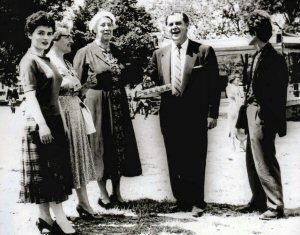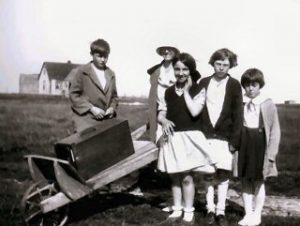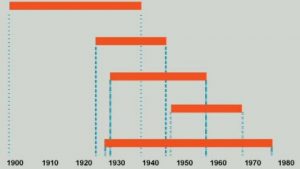Women Folklorists
Role of Women in Early 20th Century Folklore
“I embrace the common, I explore and sit at the feet of the familiar, the low…the meal in the firkin; the milk in the pan; the ballad in the street; the news of the boat; the glance of the eye; the form and the gait of the body.”
The Collected Works of Ralph Waldo Emerson (Cambridge, Mass: Belknap Press of Harvard University, 1971), 1: 67-68.
Why were so many men and women interested in collecting ballads at the turn of the century?
America’s aesthetic of the “common man” grew out of the thinking and writing of Ralph Waldo Emerson (1803-1882).

The use of the common person’s art as the ideal American aesthetic linked something functional and useful to the ideals of democracy upon which the idea of America was based. Emerson and the Transcendentalists, such as Thoreau, were interested in reclaiming the tradition of the “common man” as part of their rejection of the excesses of European materialism of the Victorian age.
In the 1900s, American colleges emphasized English language and literature in addition to their primary focus on preparing men for the ministry. The combination of the emphasis on the common man with the study of English literature naturally led to an interest in folk literature such as legends and ballads. Influenced by European scholars such as the Grimm brothers, Francis James Child, who held the first chair of literature at Harvard University, began to collect ballads. Due to his anthology of 304 English and Scottish ballad types, Child became the best-known ballad scholar in America. His students and other collectors began looking for these classic “Child ballads” throughout America.
Why did so many women in New England collect ballads?
Harvard scholars (all men) set their sights on proving the “purity” of ballads as a means of fashioning an American identity based upon British antecedents. The more Child ballads they could find, unaltered, in America, the more closely they could tie the United States to its British heritage. Elsewhere in America, especially at Columbia University under the direction of Franz Boas, American anthropology gave birth to a collecting frenzy. Anthropologists began collecting the “vanishing” Native American folklore. The American Folklore Society was formed in 1888, the same year that collector Fannie Hardy Eckstorm graduated from Smith College and began collecting ballad texts in New England libraries. The major goal of both the literary folklorists of Harvard and the anthropological folklorists of Columbia was to collect the vanishing remains of folklore in America, as authentic American cultural forms. But interested, educated people also collected ballads as a compatible pastime they either supported financially, or took part in directly.
Women began to attend college in the 1870s and most of the teachers at New England’s women colleges were taught by professors educated at Harvard. Educated women of the time had very few careers open to them. One career that was acceptable for an educated woman was writing. Collecting and writing about American culture as it manifested in ballads was a relatively acceptable practice for women, though they frequently apologized for treading on men’s territory (see the section on Eckstorm and Colcord).
How did women folklore collectors create community?
By collecting regional ballads, women folklorists reinforced the sense of these regions as folk communities. Their writing authenticated the ballad as a true American type, giving life to a vanishing oral form. All of the women placed notices in the newspapers that they were looking for ballads and singers, and many people corresponded with them. The public received a sense of local and regional pride in their folk culture as a result of the bolstering of the genre by these women writers. In addition, their collecting and publishing efforts gained the attention of scholars like Phillips Barry and Alan Lomax who corresponded and sometimes collaborated with the women.
Women collectors also created community among themselves. Fannie Hardy Eckstorm is the central figure among the women featured in this exhibit. She began collecting and publishing first, and corresponded with Helen Hartness Flanders during the 1930s and 40s (58 letters). In addition, Eckstorm arranged to have Flanders’ series of newspaper articles on New England folksongs reprinted in the Bangor Daily News, where it continued as a weekly column from November 24, 1933 to April 9, 1934. Eckstorm also corresponded with Joanna Colcord during the 1930s and 40s.
Women folksong collectors in New England had a strong sense of regionalism. They wanted to prove that there were more and better British ballads in New England than in the southern United States, for example. In the 1930s, Helen Hartness Flanders aided folklorist Phillips Barry in his quest for Child ballads in New England. At the time, folklorists believed that the South was the only place where Child ballads were still part of oral tradition. Helen Hartness Flanders collections helped prove that this was not the case, as her efforts located many Child ballads within Vermont alone. By 1933 she had found 48 Child ballad types in Vermont, equaling the number collected in Virginia up to that time, proving that New England was also heir to the British ballad tradition.

When Helen Creighton began collecting folksongs, tape recorders were a thing of the future. Yet she wanted to get the tune of the songs as well as the words. Her solution was to take with her a melodeon, a type of portable keyboard, on which Creighton could play the tune until the singer agreed that it was right. In this photo we see Creighton and local children wheeling the melodeon to a singer on Devil’s Island in Halifax Harbor.
In Songs and Ballads from Nova Scotia, Creighton remembers this scene:
“At the end of its reign, however, I’m afraid it got rather puffed up with conceit, for wherever we went, people made a great fuss over it. It was not until later, when we had been on Devil’s Island for some time, however, that it finally raised strenuous objection, when a blow was given to its pride. It had been necessary to push it over the bumps and rocks of the island, conveying it by the plebeian method of the wheelbarrow. There had been no objection when pirate songs had been played on its pious keys, but its heart was broken by the ignominy of this mode of transportation. Thus it gave a weary groan, a wheeze and a heavy sigh, but not until all had been accomplished that I required of it. For by this time a dictaphone had been tried and found infinitely more satisfactory”.
Fannie Hardy Eckstorm Joanna Colcord Helen Hartness Flanders Louise Manny Helen Creighton |
 |
Chart depicting the years of careers spanned by women folklorists. The names on the left are hyperlinked and by clicking on them, you can learn more about them.
In a 1938 letter to Colcord, Eckstorm says: “Mary Smyth was probably the only other person in the state who was so unmusical-which must be the reason why we both set out to collect songs.” Eckstorm’s humorous comment indicates the amateur nature of these women’s efforts. Few of them were trained folklorists, and only Helen Hartness Flanders had a background in music. All of the women featured in our exhibit had to find ways of working around their lack of ability to transcribe the tunes for the songs, which led them to experiment with many early, and cumbersome, types of recording equipment.
At least one letter from Eckstorm exists in the Creighton correspondence. In her 1934 interview with Miles Hanley, Eckstorm makes the following reference to Helen Creighton and Helen Flanders:
“We must have recorded more than a hundred, nearly two hundred perhaps, while Mr. Barry was down here, and we had hundreds before. We have extended the work by joining sympathetically with Mrs. Flanders in Vermont, and the other workers there, to make it a continuous work throughout the Northern part of New England. And I trust that we shall enlist the people who are working in Nova Scotia and down that way, since its all the Northeast, a continuous district, to work sympathetically with us. We don’t want to intrude on their field, going outside the national borders, but if they want to join in and study the results together I think should be a very good thing.”
Fannie Hardy Eckstorm, interviewed by Miles L. Hanley, Associate Director of the Linguistic Atlas of New England, in the summer of 1934. NA1297.
